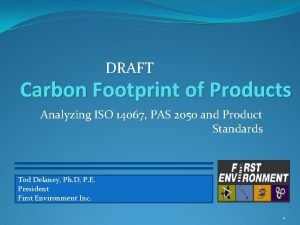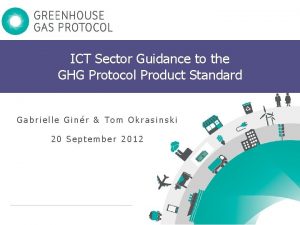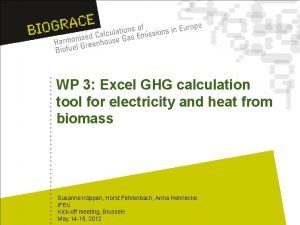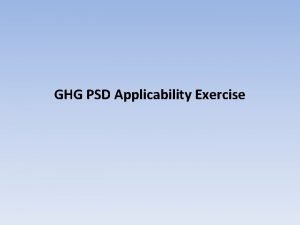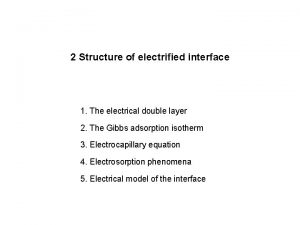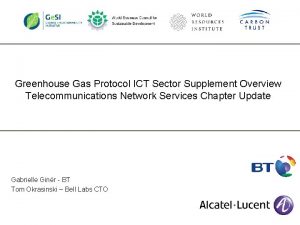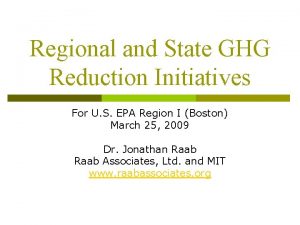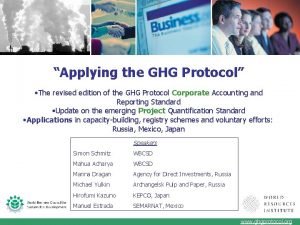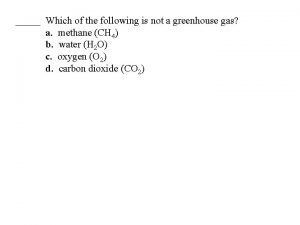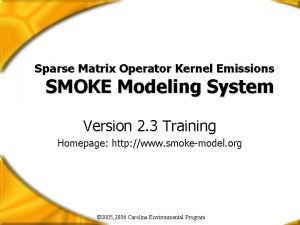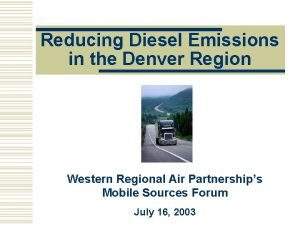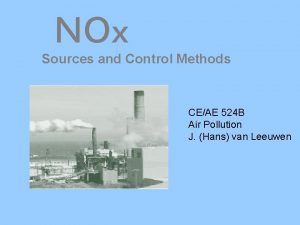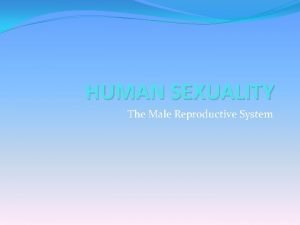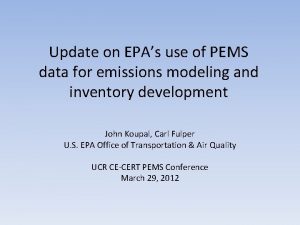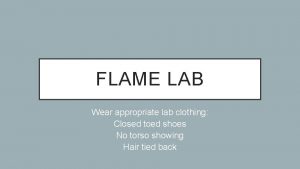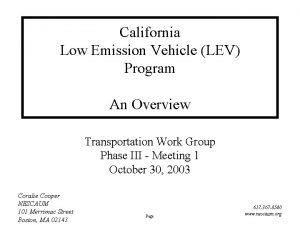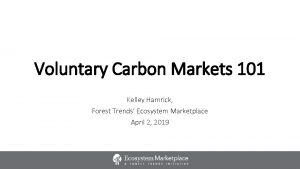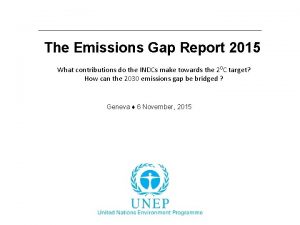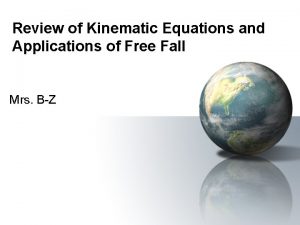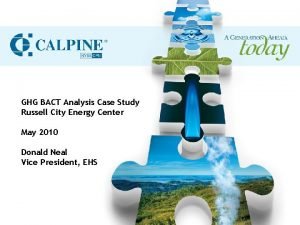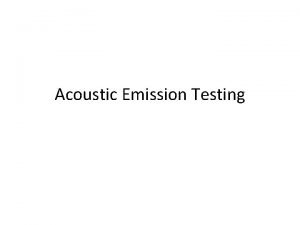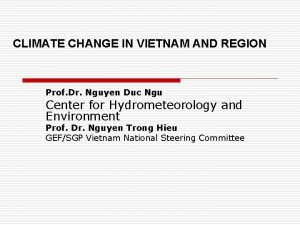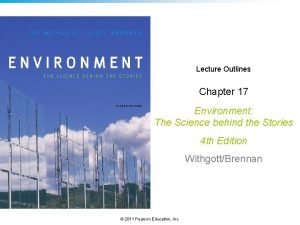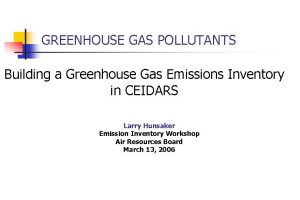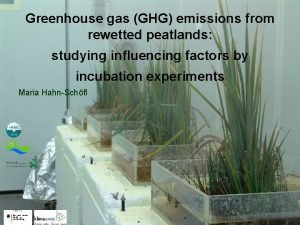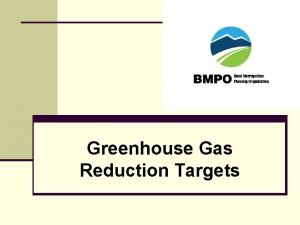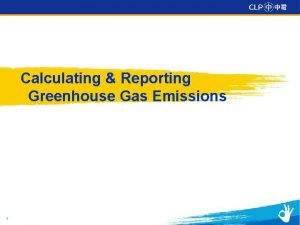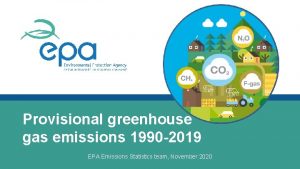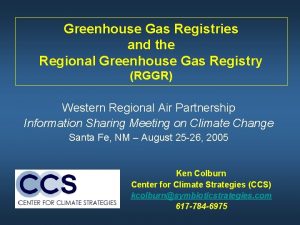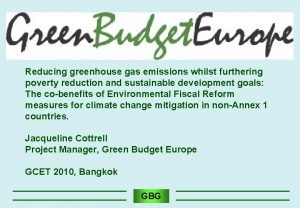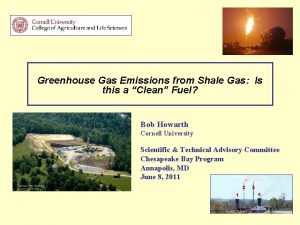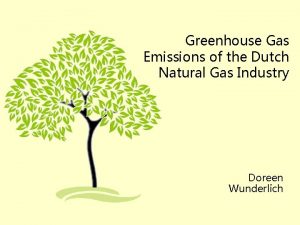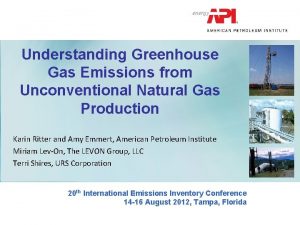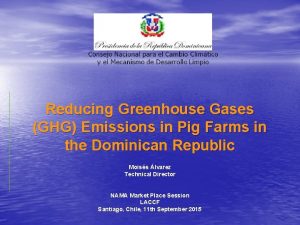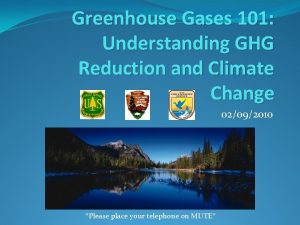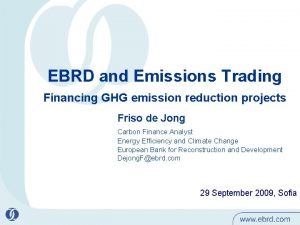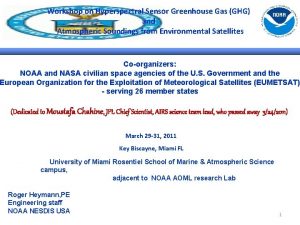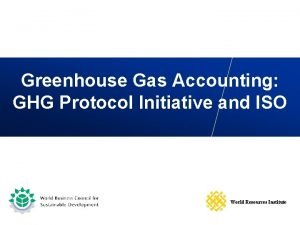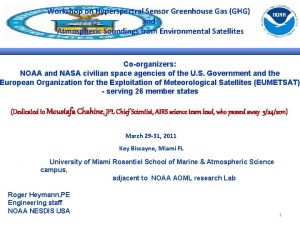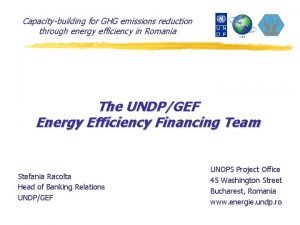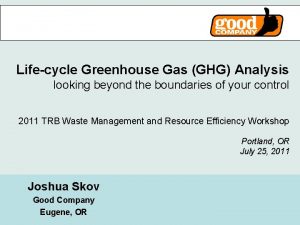Radio and Reduction of Greenhouse Gas GHG Emissions


























- Slides: 26

Radio and Reduction of Greenhouse Gas (GHG) Emissions Alexandre VASSILIEV ITU, Radiocommunication Bureau (BR) Radiocommunication Study Group Counsellor BR Focal Point on Radiocommunications and Climate Change ITU Symposium on ICTs and Climate Change Quito, Ecuador, 8 -10 July 2009

Radio and Minimizing GHG Emissions Main directions/activities: Minimizing GHG emissions from radio equipment/systems - The use of advanced technologies, such as modern chips, coding and compression technic, digital modulation allowed significantly reduce power consumption per unit for almost all radio applications. The use of radio-based devices/systems for reduction in other sectors - Wireless devices, such as mobile phones are currently the most common way of communications, which significantly reduce commuting and travelling. Radio, in many cases, is the most economically valuable solution of the “last mile” problem. “Dematerialization” through the use of radio equipment/systems – The use of radio technologies, for example satellite systems, paves the way for Internet access from remote areas and allows to apply paperless working methods, switch from physical distribution DVDs and CDs to online delivery. Global Monitoring Carbon Dioxide Emissions - Radio-based devices called remote sensors are the main tool for the global monitoring of GHG emissions. 2 ITU Symposium on ICTs and Climate Change Quito, Ecuador, 8 -10 July 2009

Radio-based Devices and CO 2 Emissions It seems that radio-based devices are the most used telecommunication devices. According to the recent statistics there are currently in use: • more than 4 billions mobile phones; • ~ 2. 5 billions radios; • ~1. 5 billions TV sets; • plus many set-top boxes, Wi-Fi cards, powerful broadcasting transmitters, etc. Source: http: //www. itu. int/ITU-D/ict/publications/idi/2009/index. html and http: //www. nationmaster. com/graph/med_tel-media-televisions ITU Symposium on ICTs and Climate Change Quito, Ecuador, 8 -10 July 2009 3

Source: Kumar, Rakesh and Mieritz, Lars (2007) “Conceptualizing “Green IT” and data centre power and cooling issues” 2 -2. 5 % ICT global CO 2 emissions from ICTs – Is everything included? The ICT Sector itself (excluding the broadcasting sector) contributes between 2 -2. 5 per cent of GHG. Emissions from most radio devices (TV sets, broadcasting transmitters, etc. ) except mobile phones are not taken into account. Are they significant? Let’s try calculate… ITU Symposium on ICTs and Climate Change Quito, Ecuador, 8 -10 July 2009 4

TV and Set Top Box Energy Consumption Appliance Cost per kg CO 2 year per year Usage Per use Primary TV – CRT (Cathode Ray Tube) 34 -37 inch On Power 6. 5 hours a day 198. 5 W £ 47. 09 203 Standby 17. 5 hours a day 4. 2 W £ 2. 68 12 Primary TV – LCD 3437 inch On Power 6. 5 hours a day 211. 1 W £ 50. 08 215 Standby 17. 5 hours a day 1. 8 W £ 1. 15 5 Primary TV - Plasma 34 -37 inch On Power 6. 5 hours a day 263. 9 W £ 62. 61 269 Standby 17. 5 hours a day 3. 6 W £ 2. 30 10 Primary TV – Rear projection 34 -37 inch On Power 6. 5 hours a day 192. 3 W £ 45. 62 196 Standby 17. 5 hours a day 2. 0 W £ 1. 28 5 Digital TV Adapter, Terrestrial On Power 6. 5 hours a day 7. 1 W £ 1. 68 7 Standby 17. 5 hours a day 6. 4 W £ 4. 09 18 Digital TV Adapter, Terrestrial – Recorder On Power 6. 5 hours a day 17. 6 W £ 4. 18 18 Standby 17. 5 hours a day 11. 3 W £ 7. 22 http: //www. carbonfootprint. com/energyconsumption. html 31 ITU Symposium on ICTs and Climate Change Quito, Ecuador, 8 -10 July 2009 5

TV Sets Carbon Dioxide Emissions Optimistic estimation could be done using the following values: TV set power consumption: 0. 21 k. W; On power usage: 6. 5 hours a day (based on UK statistics see the previous slide). Then power average: P=0. 21× 1 500 000× 6. 5/24=85 312 500 k. W Using a coefficient 0. 4 k. G per 1 k. W/hour from a draft Deliverable 1 and calculating for 365 days and 24 hours: 85 312 500× 365× 24× 0. 4=298935000000 Kg CO 2 298. 9 million tonnes carbon dioxide! Almost the same as data centres CO 2 footprint 1! What about footpring of set-top boxes, radios, DVDs, VCRs, powerful transmitters? ? ? 1 Source: http: //www. theclimategroup. org/assets/resources/publications/Smart 2020 Report. pdf ITU Symposium on ICTs and Climate Change Quito, Ecuador, 8 -10 July 2009 6

Minimizing GHG Emissions by Introducing New Radio Technologies An impressive example in this area is a digital broadcasting Plan GE 06 developed by Regional Radiocommunication Conference 2006 for 120 countries. GE 06 Plan envisages: Ø reduction (by almost 10 times) in transmitter power due to the use of digital modulation. There are hundreds of thousands of transmitters around the world with power of up to 100 -150 k. W each. The resulting energy saving is very significant; Ø possible reduction number of transmitters due to the transmitting up to 10 TV programmes in one 8 MHz channel instead of 1 TV programme per channel. GE 06 Plan is based on ITU-R and ITU-T standards (ITU-R and ITU-T Recommendations). ITU Symposium on ICTs and Climate Change Quito, Ecuador, 8 -10 July 2009 7

Minimizing GHG Emissions – Standardization Regulations (samples) • IEC 62087 standard - the world's International standard for measuring the energy efficiency of the latest generation of plasma and LCD televisions and other devices such as cable set-top boxes; • European Commission submitted to EU Parliament a report “on mobilising Information and Communication Technologies to facilitate the transition to an energy-efficient, low-carbon economy” expecting to reap from EU legislation on smart technologies including radio technologies to tackle climate change (see at: http: //ec. europa. eu/information_society/activities/sustainable_growt h/docs/com_2009_111/com 2009 -111 -en. pdf). ITU Symposium on ICTs and Climate Change Quito, Ecuador, 8 -10 July 2009 8

Minimizing TV CO 2 Emissions - Labeling environment-friendly TVs is another way of minimizing emissions. Some samples: Energy Star programme: • based on IEC 62087 standard; • sets thresholds that would permit about 25% of the TVs on the market to receive the Energy Star label. LCD TV Association “Green TV” programme: • based on IEC 62087 standard; • sets the energy consumption thresholds of TV sets, regardless of technology; • requires incorporation of advanced features such as ambient light sensors and boosting efficiency; • takes account number of recyclable parts. ITU Symposium on ICTs and Climate Change Quito, Ecuador, 8 -10 July 2009 9

Reduction of GHG Emissions by Mobile Radiocommunications Main methods: • Sustainable energy use based on: § use of radio standby mode – power consumption can be reduced up to 40% under low traffic and by 10 -20% on overall; § optimization of remote radio units by moving RF converters and power amplifiers from the base to top of the tower – reduction up to 30%; § use of advanced air conditioners and/or passive cooling systems – 10 -15%, etc. • Use of green energy – solar panels, wind turbines, etc. These measures in combination with optimal network design and “smart” antennas will allow to reduce cellular radiocommunication network CO 2 footprint by ~ 50%. ITU Symposium on ICTs and Climate Change Quito, Ecuador, 8 -10 July 2009 10

ITU-R Activities in Minimizing Power Consumption • The World Radiocommunication Conferences (WRCs) facilitate the use of less power hungry radio technologies by incorporating the most efficient ones in the Radio Regulations – international treaty status standard. • WRCs also abolish the use of outdated radio-based applications and systems on international level. • ITU-R Study Groups carries out analyses and approve ITU-R Recommendation allowing the use of the most environment-friendly methods, applications and systems. ITU Symposium on ICTs and Climate Change Quito, Ecuador, 8 -10 July 2009 11

“Dematerialization” and Radio In terms of technologies for reducing carbon emission, the use of radiocommunications as a part of telecommunication infrastructure provides means for: • reducing business travels by “virtual presence” (teleconferences) and working at home using remote access tools; • online publications of documents; • use Internet and specifically IPTV instead of DVDs/CDs; • using e-commerce to reduce shopping trips; • online billing (to save on paper bills), etc. However, radio, in certain extend, is the next step in dematerialization – it “dematerializes” wires. ITU Symposium on ICTs and Climate Change Quito, Ecuador, 8 -10 July 2009 12

ITU-R and “Dematerialization” and Remote Wireless Collaboration The work of ITU-R Study Groups 4, 5 and 6, on multimedia, is of particular importance, notably in terms of standards for remote wireless collaboration, such as the BO, M, S Series of ITU-R Recommendations on wireless audiovisual and multimedia systems, including video-conferencing, which provides means for people to collaborate/work at a distance without needing to travel (ITU-T’s also develops Recommendations on multimedia). ITU Symposium on ICTs and Climate Change Quito, Ecuador, 8 -10 July 2009 13

Climate Neutral ITU – Radiocommunication Sector Role ITU-R and its predecessor IFRB were pioneers in application of electronic methods since 80 -th. Few examples: • voluminous ITU-R service publications, distributed to all ITU-R Member States on weekly bases, are published on DVD and Internet, that significantly reduced the amount of paper (1 space networks data – up to 1000 pages); • WRCs - the biggest ITU forums, are switching to paperless methods of work and reduced number of paper copies. WRC -07, attended by more than 2800 participants, saved several millions pages of paper; • Publication of maritime Service Publications in electronic form from 2011 (Res. 335 (WRC-07)) will save about 300 tons of paper year and reduce the carbon emissions from transporting paper copies; • All frequency assignment data (several millions) are available through electronic means. 14 ITU Symposium on ICTs and Climate Change Quito, Ecuador, 8 -10 July 2009

Radio and Environment Information Most of people think that the radio frequencies are used for radiocommunications. However, radio emissions are also used for obtaining information about the environment with which they have been in contact. Environmental information, including climate monitoring data, is currently being obtained by special measuring instruments called remote sensors. Remote sensors (passive and active) are radio devices, that derive environmental information by analyzing the characteristics of received radio waves. Space-based remote sensors are the only tools that provide environmental data on a long term, repetitive and global scale. ITU Symposium on ICTs and Climate Change Quito, Ecuador, 8 -10 July 2009 15

Remote Sensing for Climate and CO 2 Monitoring CO 2 global map July 2008 - in parts per million by volume. Altimeters identify a change of the sea level with precision of 2 to 3 cm. Modern tools measure the sea surface temperature with an accuracy of up to 0. 2 C. ITU Symposium on ICTs and Climate Change Quito, Ecuador, 8 -10 July 2009 16 16

Greenhouse Gases Observing Satellite The Japan Aerospace Exploration Agency (JAXA) launched the Greenhouse Gases Observing Satellite "IBUKI“ (GOSAT) on January 23, 2009. The data are acquired by the onboard sensor. Current ground observation points: ~ 260 (on the left) GOSAT's observation points: 56000 Source: http: //www. eorc. jaxa. jp/en/imgdata/topics/2009/tp 090319. html ITU Symposium on ICTs and Climate Change Quito, Ecuador, 8 -10 July 2009 17

ITU-R and Environment Monitoring As the steward of the global framework for spectrum, ITU-R: Ø through World Radiocommunication Conferences (WRC) allocates the radio-frequency spectrum; Ø carries out studies and develops radiocommunication standards: § treaty status Radio Regulations– 4 volumes; § voluntary standards (ITU-R Recommendations – particularly in ITU-R Study Group 7 (Science services)); to foster the operation without interference of radiobased applications and radiocommunication systems used for environment monitoring, including greenhouse gases monitoring, weather forecasting, disaster prediction, detection and mitigation of negative effect of disasters. ITU Symposium on ICTs and Climate Change Quito, Ecuador, 8 -10 July 2009 18

ITU-R Recent Decisions and Publication Related to Monitoring - WRC-07 and Radiocommunication Assembly (RA-07) adopted a number of Resolutions on studies related to remote-sensing, which is a vital component in the science of climate change. - ITU-R Recommendations on radiocommunication systems and radio-based applications operating in Earth-exploration satellite, meteorological-aids and meteorological satellite services, today provide most of data for the Global Observing System (GOS) and Global Climate Observing System (GCOS). - ITU-R Study Group 7 (Science services) in cooperation with the World Meteorological Organization produced WMO and ITU Handbook on Use of Radio spectrum for meteorology: weather, water and climate monitoring and prediction providing information on development and a proper use radiocommunication systems and radio-based technologies for environment observation, climate control, weather forecasting and natural and man-made disaster prediction, detection and mitigation. – It is the first handbook in the ITU history signed by the Secretary-Generals of two UN Agencies. 19 ITU Symposium on ICTs and Climate Change Quito, Ecuador, 8 -10 July 2009

ITU Symposium on ICTs and Climate Change Quito, Ecuador, 8 -10 July 2009 20

Supplementary Slides/ Information on ITU Radiocommunication Sector (ITU-R) Activities/Standards ITU Symposium on ICTs and Climate Change Quito, Ecuador, 8 -10 July 2009 21

Radiocommunication Study Groups Res. ITU-R 4 -5 of Radiocommunication Assembly 2007: established 6 ITU-R Study Groups: SG 1: SG 3: SG 4: SG 5: SG 6: SG 7: Spectrum management Radiowave propagation Satellite services Terrestrial services Broadcasting service Science services In addition: CCV: Coordination Committee for Vocabulary CPM: Conference Preparatory Meeting SC: Special Committee on regulatory and procedural matters http: //www. itu. int/ITU-R/go/rsg ü >900 Recommendations ü “Standards” in areas of spectrum management and radio technology ü Result of consensus from meetings of world-wide experts ü Some referred to in RR ü Used by spectrum planners and system designers Supported by Counsellors and Assistants in Study Group Department of BR 22 ITU Symposium on ICTs and Climate Change Quito, Ecuador, 8 -10 July 2009

Application of ITU-R Standards The best samples: • Radio Regulations – applied by all countries around the World for international spectrum management; • ITU-R Regional Agreements – applied by all country parties of a given agreement (some countries are parties of several Agreements/Plans); • ITU-R M-Series Rec. – e. g. for land mobile service: there are currently > 4 billions customers (more than 50% people on the Earth) using mobile phones built in accordance with ITU-R Rec. ; • ITU-R BT&BR-Series Rec. – used for broadcasting (TV and sound). There are more than 1. 5 billions TV sets based on ITU-R standards; • ITU-R standards for the use of radiocommunication services/systems for emergency situations; • etc. . ITU Symposium on ICTs and Climate Change Quito, Ecuador, 8 -10 July 2009 23

ITU-R Publications • BR International Frequency Information Circular (IFIC) – terrestrial and space services • Space Radiocommunication Stations on DVD-ROM • Radio Regulations • electronic file (Win. Word, PDF) • CD-ROM • paper • Service documents • ITU-R Recommendations § online subscriptions § CD-ROM § paper • Handbooks, etc. http: //www. itu. int/publications ITU Symposium on ICTs and Climate Change Quito, Ecuador, 8 -10 July 2009 24

ITU-R Recommendation series BO: BR: BS: BT: F: M: P: RA: RS: S: SA: SF: SM: SNG: TF: V: Satellite delivery Recording for production, archival and play-out; film for television Broadcasting service (sound) Broadcasting service (television) Fixed service Mobile, radiodetermination, amateur and related satellite services Radiowave propagation Radio astronomy Remote sensing systems Fixed-satellite service Space applications and meteorology Frequency sharing and coordination between fixed-satellite and fixed service systems Spectrum management Satellite news gathering Time signals and frequency standards emissions Vocabulary and related subjects ITU Symposium on ICTs and Climate Change Quito, Ecuador, 8 -10 July 2009 25

Some ITU-R Web Pages Main ITU-R Web page: http: //www. itu. int/ITU-R Terrestrial Services: http: //www. itu. int/ITUR/terrestrial Space Services: http: //www. itu. int/ITU-R/space Study Groups: http: //www. itu. int/ITUR/index. asp? category=studygroups&rlink=rsg&lang=en ITU-R Publications: http: //www. itu. int/publications/sector. aspx? sector =1&lang=en ITU Symposium on ICTs and Climate Change Quito, Ecuador, 8 -10 July 2009 26
 Iso 14067 carbon footprint of products
Iso 14067 carbon footprint of products Ghg protocol ict sector guidance
Ghg protocol ict sector guidance Biograce
Biograce Ghg exercise
Ghg exercise Structure of electrified interface
Structure of electrified interface Ghg protocol ict sector guidance
Ghg protocol ict sector guidance U.ghg
U.ghg Ghg protocol revised
Ghg protocol revised Which of the following is not a greenhouse gas?
Which of the following is not a greenhouse gas? Trunked radio vs conventional radio
Trunked radio vs conventional radio Volkswagen code of ethics
Volkswagen code of ethics Sparse matrix operator kernel emissions
Sparse matrix operator kernel emissions Diesel emissions denver
Diesel emissions denver Sources of nox emissions
Sources of nox emissions Nocturnal emissions causes
Nocturnal emissions causes Pems emissions modeling
Pems emissions modeling Where else have you observed colorful light emissions
Where else have you observed colorful light emissions California lev
California lev State of the voluntary carbon markets 2017
State of the voluntary carbon markets 2017 Un emissions gap report
Un emissions gap report Luke autbeloe drops a pile of roof shingles
Luke autbeloe drops a pile of roof shingles Using citys heat reduce emissions
Using citys heat reduce emissions Application of acoustic emission testing
Application of acoustic emission testing Ghs emissions
Ghs emissions Particulates can be removed from smokestack emissions by
Particulates can be removed from smokestack emissions by Gas law
Gas law Difference between ideal gas and real gas
Difference between ideal gas and real gas
